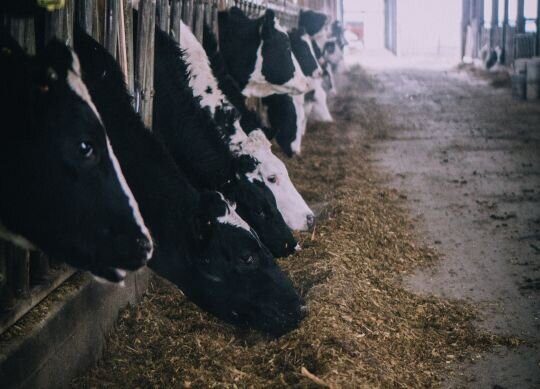Managing Mycotoxins in Dairy Rations
Mycotoxins are a type of secondary metabolites produced by molds. Most nutritionists and producers may rightly associate mold and mycotoxins in feed, but it is important to recognize that the presence of mold does not necessarily mean that mycotoxins are present, and conversely, just because there is no visible mold, it does not mean that no mycotoxins are present. Mold counts can still be a valuable tool for managing mycotoxins in the ration. Note that molds are a type of fungi, and for the purposes of this article, these terms will be used interchangeably.
The main fungi that produce mycotoxins in feed are Aspergillus, Fusarium, and Penicillium.
– Aspergillus is responsible for the production of aflatoxins. Aflatoxins are a concern in livestock feed, because they can be transmitted into milk and meat, and they are a known carcinogen in humans. Aflatoxin B1 (AFB1) is the most carcinogenic and the main toxin of concern.
– Fusarium species are responsible for the production of several well-known mycotoxins, including the tricothecenes (e.g., T-2, HT-2, deoxynivalenol (DON), and diacetoxyscirpenol (DAS)), fumonisins, and zearalenone (ZEA).
– The main Penicillium species of concern is P. roqueforti, also known as the “silage mold” because it grows well under ensiling conditions such as low pH and limited oxygen. Toxins produced by these molds include PR toxin, mycophenolic acid, and roquefortine C.
In general, molds that produce mycotoxins can be classified as “field fungi” or “storage fungi,” depending on where they proliferate. Fusarium species are considered field fungi because their conditions for growth are best during plant growth and maturing. These molds flourish particularly well during periods of high humidity and when the temperature fluctuates between hot days and cool nights. Although the Fusarium molds themselves are susceptible to ensiling conditions and are mostly killed off during the process, the toxins are stable under these conditions, so the concentration of toxins in silage is proportional to the concentration in the field. Aspergillus and Penicillium are both storage fungi, but both can grow in the field under certain conditions. Penicillium thrives under ensiling conditions.
Prevention of mycotoxin contamination is the most effective way of managing mycotoxin levels in feed, but environmental factors may make this impossible in some years. Minimizing environmental stress will mitigate mycotoxins in the pre-harvest stage. This can be accomplished in part by choosing the right hybrids for your region, applying appropriate fungicides and pesticides, irrigating, fertilizing, crop rotation, and eliminating residues. Insect management is important for the control of aflatoxins, both because insects can be vectors for the spread of the molds that cause them and because insect damage can make crops more susceptible to contamination. Following best practices during harvest and storage or ensiling of feeds can also mitigate mycotoxin contamination. Proper timing of harvest, minimal soil contamination, and immediate storage are important practices during harvest. During ensiling, adequate packing density and the use of oxygen barriers can promote rapid anaerobic fermentation, which will prevent the formation of most fungi, but has limited effect on Penicillium species. Bunk face management, including a smooth face and adequate feed-out speed, will limit the exposure of silage to oxygen during the feeding phase, and will prevent fungal growth.
Once mycotoxins are in the feed, the amount in the ration must be managed. Dilution (mixing contaminated and uncontaminated feeds) is a common practice but should be used with caution. A low feed-out rate could worsen mold growth and mycotoxin contamination. Use of adsorbents in feeds to “bind” mycotoxins is recommended for some mycotoxins, particularly aflatoxins. Clay adsorbents—such as aluminosilicates, montmorillonite, bentonites, zeolites, and clinoptilolites—are effective in many conditions. Aflatoxins get trapped in the porous structure of these compounds because of a slight imbalance of electrical charges. Yeast-based products have also been used as adsorbents. Yeast cell wall components can trap aflatoxins as well as ochratoxin and T-2, and there is in vitro evidence that they can bind ZEA.
When testing for mycotoxins, collecting a representative sample of feed is critical, since mycotoxins are often isolated in “hot spots” rather than dispersed uniformly throughout a feed. Larger samples will significantly reduce variation in sample results, and pooling several samples (e.g., 8-10) over multiple feedings (e.g., 3-5) will help ensure that a sample is representative. For field fungi, harvest may be the easiest time to collect samples to proactively manage molds and mycotoxins. If testing is being performed in response to observed changes in health and/or performance, it may be advisable to test the TMR first before analyzing suspect feeds. Isolated pockets of mycotoxins may be broken up and distributed through the feed in the process of mixing TMR, but collecting a representative sample is still imperative because variation is present.
Fortunately, ruminants are more resilient to mycotoxins than non-ruminants due to the deactivation of mycotoxins into non-toxic intermediates in the rumen. Still, interacting factors can determine the extent of negative effects of mycotoxins on cattle. Young calves, transition cows, and high-producing cows are the most susceptible to mycotoxins. There is evidence that the efficiency of adsorbents for managing aflatoxins can depend on undetermined rumen fluid factors and that degradation activity of some toxins, such as ochratoxin, can depend on the time of day relative to the feeding cycle. Aflatoxin is not readily degraded in rumen fluid compared to other toxins, and the amount of DON that is deactivated varies across studies. Protozoa are active in deactivating several toxins, including ochratoxin, ZEA, T-2, and DAS.
Adapted from CSA Animal Nutrition



